Related Research Articles

The British Museum is a public museum dedicated to human history, art and culture located in the Bloomsbury area of London. Its permanent collection of eight million works is the largest in the world. It documents the story of human culture from its beginnings to the present. The British Museum was the first public national museum to cover all fields of knowledge.
The Iron Age is the final epoch of the three historical Metal Ages, after the Chalcolithic and Bronze Age. It has also been considered as the final Age of the three-age division starting with prehistory and progressing to protohistory. In this usage, it is preceded by the Stone Age and Bronze Age. These concepts originated for describing Iron Age Europe and the Ancient Near East. Still, they now include other parts of the Old World. The indigenous cultures of the New World did not develop an iron economy before 1500.

The first millennium of the anno Domini or Common Era was a millennium spanning the years 1 to 1000. The world population rose more slowly than during the preceding millennium, from about 200 million in the year 1 to about 300 million in the year 1000.
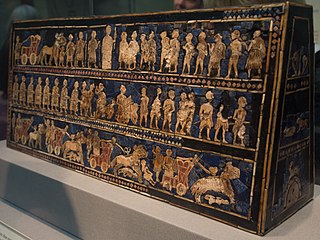
Ancient history is a time period from the beginning of writing and recorded human history through late antiquity. The span of recorded history is roughly 5,000 years, beginning with the development of Sumerian cuneiform script and continuing until the expansion of Islam in late antiquity. Ancient history covers all continents inhabited by humans in the period 3000 BC – AD 500. The three-age system periodizes ancient history into the Stone Age, the Bronze Age, and the Iron Age, with recorded history generally considered to begin with the Bronze Age. The start and end of the three ages vary between world regions. In many regions the Bronze Age is generally considered to begin a few centuries prior to 3000 BC, while the end of the Iron Age varies from the early first millennium BC in some regions to the late first millennium AD in others.
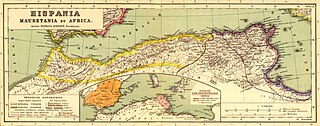
Mauretania is the Latin name for a region in the ancient Maghreb. It extended from central present-day Algeria to the Atlantic, encompassing northern present-day Morocco, and from the Mediterranean in the north to the Atlas Mountains. Its native inhabitants, of Berber ancestry, were known to the Romans as the Mauri and the Masaesyli.

Limes is a term used primarily for the Germanic border defence or delimiting system of Ancient Rome marking the borders of the Roman Empire. The term has been extended in modern times to refer to the frontier defences in other parts of the empire, such as in the east and in Africa.

Great Zimbabwe is a medieval city in the south-eastern hills of the modern country of Zimbabwe, near Lake Mutirikwe and the town of Masvingo. It was the capital of the Kingdom of Zimbabwe from the 13th century, having been settled in the 4th century AD. Construction on the city began in the 11th century and continued until it was abandoned in the 15th century. The edifices were erected by ancestors of the Shona people, currently located in Zimbabwe and nearby countries. The stone city spans an area of 7.22 square kilometres (2.79 sq mi) and could have housed up to 18,000 people at its peak, giving it a population density of approximately 2,500 inhabitants per square kilometre (6,500/sq mi). It is recognised as a World Heritage Site by UNESCO.

The Roman provinces were the administrative regions of Ancient Rome outside Roman Italy that were controlled by the Romans under the Roman Republic and later the Roman Empire. Each province was ruled by a Roman appointed as governor.
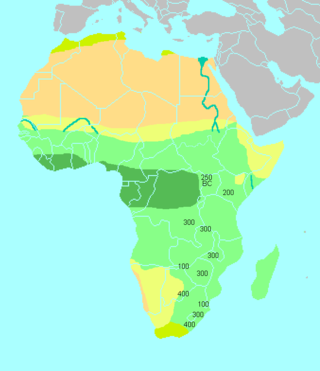
The Bantu expansion was a major series of migrations of the original Proto-Bantu-speaking group, which spread from an original nucleus around West-Central Africa. In the process, the Proto-Bantu-speaking settlers displaced, eliminated or absorbed pre-existing hunter-gatherer and pastoralist groups that they encountered.

The Africanis is a dog landrace found across southern Africa. It is a medium-sized, short-coated dog, with a distinctive black patch around the front of the muzzle.
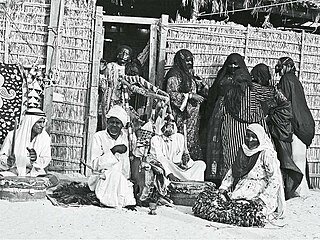
Afro-Arabs, African Arabs, or Black Arabs are Arabs who have predominantly or total Sub-Saharan African ancestry. These include primarily minority groups in the United Arab Emirates, Yemen, Saudi Arabia, Oman, Kuwait, Qatar, and Bahrain, as well as Iraq and Levant: Syria, Palestine, and Jordan. The term may also refer to various Arab groups in certain African regions.

The Datooga are a Nilotic ethnic people group from Tanzania, located in Karatu District of Arusha Region and historically in areas of southwest Manyara Region and northern Singida Region. In 2000, the Datooga population was estimated to number 87,978.

The Mthethwa Paramountcy, sometimes referred to as the Mtetwa or Mthethwa Empire, was a Southern African state that arose in the 18th century south of Delagoa Bay and inland in eastern southern Africa. "Mthethwa" means "the one who rules".
"Tar Baby" was the name given by the United States State Department to Richard Nixon's policy during the late 1960s and 1970s of strengthening contacts with the white-minority governments in Rhodesia and apartheid-era South Africa. The allusion was to the Uncle Remus story in which Brer Fox tries to capture Brer Rabbit by making a tar baby. Brer Rabbit strikes the tar "baby" with his hands, feet, and head and eventually becomes completely adhered to it. The policy option, described as a partial relaxation of economic action against Rhodesia and South Africa, and derived from NSSM: 39, was based on the presumption that apartheid and colonial rule were an unpleasant but undeniable reality and that Washington should accommodate itself pragmatically to the status quo. According to Nixon, if the United States was to be an influence for enlightened change it must do so by offering the "carrot" and eschewing the "stick". This policy would have to be pursued ad infinitum to get it to work.
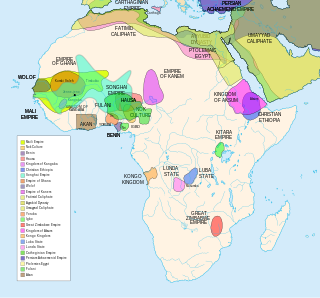
African empires is an umbrella term used in African studies to refer to a number of pre-colonial African kingdoms in Africa with multinational structures incorporating various populations and polities into a single entity, usually through conquest.
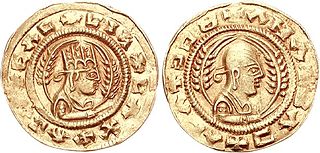
The Kingdom of Aksum also known as the Kingdom of Axum, or the Aksumite Empire, was a kingdom in East Africa and South Arabia from classical antiquity to the Middle Ages. Based in what is now northern Ethiopia and Eritrea, and spanning present-day Djibouti and Sudan. Emerging from the earlier Dʿmt civilization, the kingdom was founded in 1st century. The city of Axum served as the kingdom's capital for many centuries until it relocated to Kubar in the 9th century due to declining trade connections and recurring external invasions.
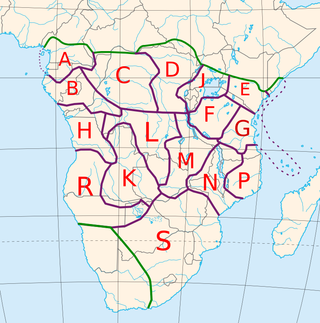
The Bantu peoples are an ethnolinguistic grouping of approximately 400 distinct native African ethnic groups who speak Bantu languages. The languages are native to 24 countries spread over a vast area from Central Africa to Southeast Africa and into Southern Africa.

Kasie FM is a South African community radio station based in Ekurhuleni. It was founded in 1997, but started broadcasting full-time late 2007.

Between the first century BC and the fourth century AD, several expeditions and explorations to Lake Chad and western Africa were conducted by groups of military and commercial units of Romans who moved across the Sahara and into the interior of Africa and its coast. However, there was a more significant Roman and Greek presence in modern-day Eritrea and Ethiopia. The primary motivation for the expeditions was to secure sources of gold and spices from Axumite piracies.